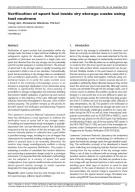Details
- Identification
- ISSN: 1977-5296, DOI: 10.3011/ESARDA.IJNSNP.2019.14
- Publication date
- 1 December 2019
- Author
- Joint Research Centre
Description
Volume: 59, December 2019, pages 47-56,
Authors: Young Ham, Shivakumar Sitaraman, Phil Kerr
Lawrence Livermore National Laboratory
Abstract: Verification of spent nuclear fuel assemblies within dry storage casks has been a major technical challenge for the safeguards regime for decades. Multiple significant quantities of plutonium are present in a single cask, and spent fuel diverted from the dry storage can be potentially used for nuclear weapons or nuclear terrorism. The amount of spent fuel in dry storage casks is rapidly increasing and is expected to triple in one or two decades. Conventionally, spent fuel accountancy in dry storage relies on containment and surveillance approaches, and there are no reliable technical means to re-verify the casks content once a breach in the continuity-of-knowledge occurs or an intrusion is suspected. Application of non-destructive assay methods is significantly limited by close packing of assemblies in storage configuration and extensive shielding that prevent reliable evaluation of gamma-ray and neutron signatures on the periphery of the cask. Although multiple solutions have been investigated in the past, none of them worked properly. This problem remains as the priority for the IAEA Spent Fuel Verification and Monitoring Programs and national regulatory authorities.
The Lawrence Livermore National Laboratory research team has developed a novel approach to address the verification issue of spent fuel in dry storage casks. A modeling and experimental study investigates a spatiallydependent fast- and epi-thermal neutron flux distribution measured at the top surface of the dry storage cask. The neutron intensity pattern is collected over a grid within a specified energy range, resulting in a set of images that characterize the assembly loading configuration. If a gross defect is present (due to an assembly diversion), the neutron map image unambiguously exhibits a strong deviation from the expected distribution. The project is evaluating a number of candidate fast neutron detectors and conducting a parametric design study for a prototype instrument. It is expected that this verification methodology can be adapted to a variety of spent fuel cask configurations: from typical metal/concrete enclosures for above-ground interim storage to metal capsules designated for deep geological disposal.
Keywords: spent nuclear fuel; dry cask storage; fast neutron spectroscopy; stilbene; liquid scintillator
Reference guideline:
Ham, Y., Sitaraman, S., & Kerr, P. (2019). Verification of spent fuel inside dry storage casks using fast neutrons. ESARDA Bulletin - The International Journal of Nuclear Safeguards and Non-proliferation, 59, 47-56. https://doi.org/10.3011/ESARDA.IJNSNP.2019.14

